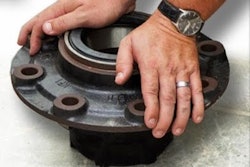The winter season wreaks havoc on a truck's suspension system and leaves truck parts like shock absorbers, stiff, brittle and unable to properly function through adverse road conditions like potholes.
With the arrival of Spring, now is time to discuss the importance of inspecting these parts early in the season for possible replacement. Replacement before long-haul trips can improve shock absorber performance and avoid potential dangers of failing shock absorbers.
“Stiff” shocks are caused by cold oil, a common problem in the winter season. According to DIYAutoService, “a drastic decrease in temperature causes your shock absorbers to restrict the movement of fluid through the metering holes as the oil inside gets thicker and denser.”
Shocks that cruised on salty roads during winter may have corroded over time, too. Match Made Parts, a leading supplier of aftermarket shock absorbers, states that weak welding, cracked bushings and excessive oil loss are other reasons shocks may fail. Driving with bad shocks is never a good idea and will create bumpier rides for truckers.
How to inspect shocks on trucks
Drivers will need to observe the warning signs of failing shock absorbers to determine if they need replacement. Monroe, a leading supplier of shocks and struts, points out that uneven tire wear, noticeable road vibrations in the steering wheel, knocking sounds and unstable bouncy rides are all symptoms of bad shocks.
A “bounce test” will help diagnose if truckers are driving with faulty shocks and can be performed in an empty parking lot or in a repair shop. It is important to note that a good shock will not bounce back quickly when pressed. If conducting the bounce test in a parking lot, see if the truck’s rear continues to bounce after stomping down on the brake. If it does then the rear shocks are worn. (On cars, a bounce test can be done by pushing down on one corner of the vehicle. If cars bounce more than twice, it is time for replacement.)
Truckers will also need to visually inspect shocks to see if they are free from dents, bends and oil spills. If they are not smooth to touch, it is time to switch out shocks for new ones. Typically, shock absorbers should be replaced every 150,000 miles, according to Match Made Parts.
The dangers of not replacing shocks
You know the saying “April showers bring May flowers?”
Well, wet surfaces also lead to more road accidents. Driving with worn shocks affects brake efficiency and puts drivers at risk of skidding on wet pavement. It also causes drivers to lose control more easily when driving over bumps and dips. Lastly, driving with worn shocks can create a domino effect on other truck parts and prematurely ruin steering, braking and other suspension components.
How to increase shock performance this season
Take a few minutes to allow the truck to warm-up before leaving the terminal. Like tires, shocks have an optimal operating temperature that helps improve performance. According to shock and strut manufacturer Gabriel, shock absorbers function at temperatures ranging from ambient to 350 degrees Fahrenheit. With warmer fluid in the shock, there will be a better flow. The spring in shocks may heat up and help improve performance, too. By warming up the truck, the suspension components will work together to help guide the vehicle to a smoother safer ride.
Now that warmer weather is here to stay, it is time to inspect suspension system parts that may have been harmed by winter’s wrath. Start by checking on shock absorbers and make replacements based on the truck application before making any long-haul trips this season.
Jennifer Smith is an e-Commerce Digital Content Specialist for JIT Truck Parts in Highland Park, Illinois.












